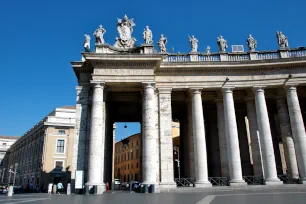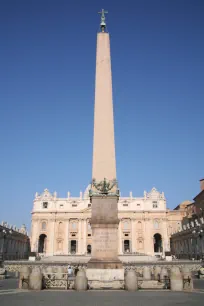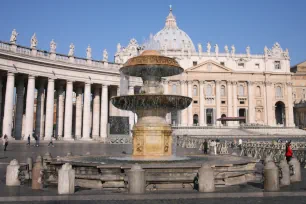St. Peter’s Square, known locally as Piazza San Pietro, was created in the seventeenth century by Bernini. The square, which is located in Vatican City and borders St. Peter’s Basilica, is an architectural highlight.
Creation



As soon as Alexander VII was elected as the new pope in April 1655, he commissioned sculptor and architect Gian Lorenzo Bernini to create a new square in front of the St. Peter’s Basilica. Following Alexander’s detailed instructions, Bernini came up with an elliptical shaped square, 240 meters wide and 196 meters long (787 x 643 ft.). Construction of the square started in 1656 and was completed eleven years later, in 1667.
The Square
St. Peter’s Square is bordered on two sides by semicircular colonnades which, according to Bernini, symbolize the stretched arms of the church embracing the world. The colonnades were built in 1660 and consist of four rows of columns with in total 284 Doric columns and 88 pilasters. The columns are 20 meters tall (66 ft.) and 1.6 meters wide (5 ft.). 140 statues were installed on top of the colonnades, all created by Bernini and his students. They depict popes, martyrs, evangelists and other religious figures.
To the left and right of the central obelisk on the square are circular marble plates which indicate the foci of the elliptical square. When you stand on either of these plates and look at the nearest colonnade, it will look as if there is only one row of columns instead of four. Bernini wasn’t just a great sculptor and architect, he also knew his geometry!
On special occasions such as the election of a new pope or on Easter, almost 400,000 people fill the expansive square.
Obelisk and Fountains

In the center of the square stands an Egyptian obelisk, 25.5 meters tall – 41 meters (135 ft.) including the pedestal. The obelisk was originally located at Heliopolis in Egypt and was built for Cornelius Gallus, the city’s prefect.
In 37 AD, Caligula decided to transport the obelisk to Rome with a specially constructed ship. It was installed at the spina of the Circus of Caligula (later known as Circus of Nero), which was located in an area now occupied by Vatican City.



In 1585 Pope Sixtus V decided to have the obelisk moved to its present location in front of the then under construction St. Peter’s Basilica, a distance of about 300 meters. The relocation was a daunting task, however, and even Michelangelo considered it impossible. Sixtus however persevered and commissioned Domenico Fontana with the transportation.
It took 900 men and a reported 75–140 horses and even though the ropes were on the verge of breaking, Fontana succeeded on September 10, 1586, after an operation that lasted five months.
In 1613 a fountain designed by Carlo Maderno was installed on the square, to the right of the centrally located obelisk. To maintain symmetry, Bernini decided to install an identical copy of the fountain on the left side. The fountain was created in 1677 by Carlo Fontana.
St. Peter’s Basilica
St. Peter’s Square creates a magnificent entry point to the St. Peter’s Basilica, which was built between 1506 and 1626 and borders the square to the west. The basilica is the largest in the world. Its interior is decorated with magnificent monuments, many of which were created by the great Bernini.
Make sure you climb all the way to the top of the basilica’s imposing dome – designed by another great artist – Michelangelo – as it offers a magnificent view over the square.
- Next: Pyramid of Caius Cestius
- More Sights & Attractions in Rome
- Related articles:

